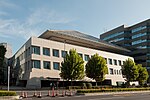Sophia University, also known by its Japanese name 上智大学 (Jōchi Daigaku), is a private research university in Japan. Sophia is one of the 3 prestigious Sōkeijōchi (早慶上智) private universities, a group of the top 3 private universities in Japan with the other 2 being Keio University and Waseda University, according to the Times Higher Education. It is also ranked number 18 in the 2021 Times Japan University Rankings. Founded by the Roman Catholic religious order of the Society of Jesus in 1913, the university has grown from its 3 original academic departments of Philosophy, German Literature, and Commerce to 9 undergraduate Faculties and 10 Graduate Schools, with over 13,900 students in total at the present moment.Sophia shows a rapid growth since it was established and it is known for its diversity. In fact, the university has been a leader in the internationalisation of Japanese universities. It conducts classes both in English and Japanese to welcome students from overseas such as China, South Korea, and Europe. There are international students from 77 countries and it has forged agreements with 298 overseas universities in 59 countries to encourage students joining the exchange programs with several other top universities throughout the world, including Georgetown University, Yale University, The University of Georgia, Sogang University, Hong Kong University, and the University of Cologne.
Sophia also gained national repute as the leading institution in globalisation, foreign languages, and literature in Japan. As a prominent institution for research and higher learning in the fields of the social sciences, humanities, and natural sciences, the university has been selected by the Japanese Ministry of Education to be one of 37 universities to receive funding for its internationalisation efforts through the "Top Global University Project". The university has been ranked as top 3rd Catholic university in AsiaSophia is also nationally acclaimed for its research prowess. There are many institutes and centres that support Sophia's goals in pursuing excellence in research. These institutes and centres include the Sophia Asia Centre for Research and Human Development, Semiconductor Research Institute, the Institute of International Relations, and the Institute of Media, Culture and Journalism. Sophia is also known for storing and maintaining centuries-old texts dating back from Catholic missionaries during the period of Christian persecutions in Japan between 1617 and 1632. Sophia also produces research journals, most notably the Monumenta Nipponica.
Before 1957, the university only admitted male students to degree programs, but the numbers of male and female students are now more or less equal. Sophia's alumni are referred to as "Sophians"; they include the 79th Prime Minister of Japan, Morihiro Hosokawa, several politicians represented in the Japanese National Diet, professors at various higher education institutions, and even actors and musicians in the Japanese film and music industries.








